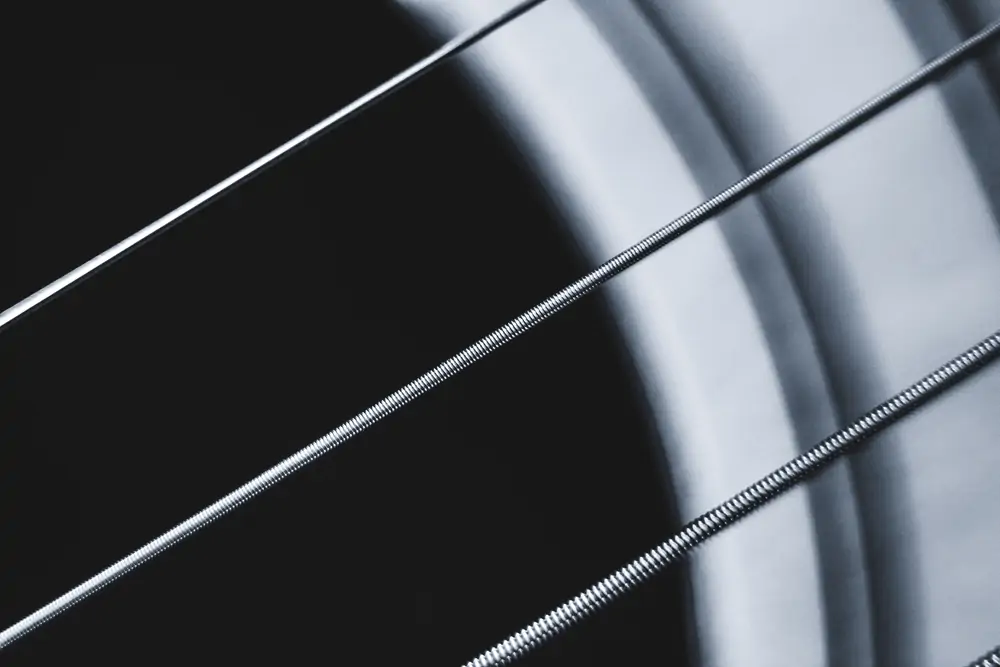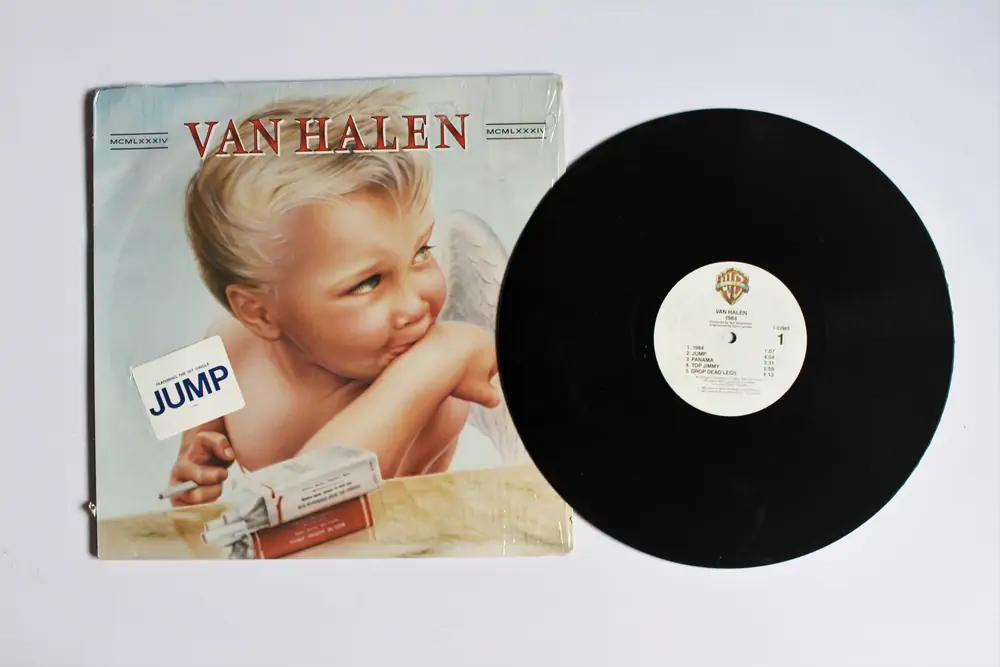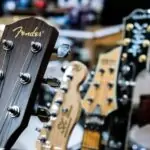Eddie Van Halen, a legendary guitarist known for his innovative playing style and groundbreaking techniques, had unique preferences when it came to the guitar strings he used.
Throughout his extensive career, his choice of strings played a crucial role in the development of his signature tone, which has inspired countless musicians around the world.

In the early days of his career, Eddie Van Halen used the Fender 150XL set (9, 11, 15, 24, 32, 40) strings. As the years went by, he made a deal with Ernie Ball, who produced the exact same set for Eddie.
Later on, he shifted to using custom-designed EVH Premium guitar strings when he moved over to Fender. These strings, combined with his unique approach to playing, allowed him to create a groundbreaking sound that would define an era of guitar-driven music.
Key Takeaways on What Gauge Strings Did Eddie Van Halen Use?
- Eddie Van Halen initially used Fender 150XL set strings, then switched to Ernie Ball and eventually EVH Premium guitar strings.
- His choice of strings played a significant role in creating his iconic tone.
- Eddie Van Halen’s string preferences have had a lasting impact on guitarists and the music industry as a whole.
Also don’t miss:
- What Gauge Strings Did Jimi Hendrix Use?
- What Strings Did Eddie Van Halen Use?
- How Many Children Did Eddie Van Halen Have?
Guitar Preferences and Specifications
Eddie’s Custom Guitars
Eddie Van Halen was known for his custom-built guitars with unique specifications, such as the famed Frankenstrat. He constantly experimented with components and designs to achieve his ideal sound and playability.
He frequently used unique combinations of woods like ash and maple to create a distinctive tone. Another renowned piece in his collection was the Bumblebee guitar, known for its black and yellow striped design.
Eddie’s Preferred Guitar Brands
In his quest for the perfect guitar, Eddie worked with several well-known brands such as Fender, Gibson, Ibanez, and Charvel. However, he found his true sound with the Kramer 5150 guitar, specifically designed to meet his needs.
Another notable collaboration was with Music Man, which resulted in the sought-after Music Man EVH signature model.
Eventually, Eddie established his own brand, EVH, and produced the widely acclaimed EVH Wolfgang series. These guitars catered to players seeking premium quality instruments without the hefty price tag.
Guitar Strings and Tuning
Eddie’s choice of string gauges and tunings also played a significant role in shaping his iconic sound. He preferred a custom set of string gauges, measured at 9, 11, 15, 24, 32, and 40. This specific set can be difficult to find, though some options might be available on online platforms like eBay.
It has been noted that Eddie sometimes used lighter gauge strings of around 7s, as mentioned by Dweezil Zappa.
In addition to his string preferences, Eddie often used the Floyd Rose tremolo system as a crucial aspect of his playing style. Furthermore, he frequently experimented with different tunings, such as E standard and various drop tunings, to expand his sonic possibilities.
Amplification and Pedals
Eddie Van Halen is widely known for his iconic guitar tone, which can be traced back to his choice of amplifiers and pedals. He was a longtime user of Marshall amplifiers, specifically a 1967/68 100-watt Marshall Super Lead, which played a major role in shaping his sound.
This particular model is praised for its harmonically rich overdrive when pushed, which appealed to Eddie and became a critical aspect of his tone.
Additionally, Eddie made use of EVH amplifiers, which were designed to cater to his specific tonal preferences. These amps provide a versatile, high-gain sound that suits Eddie’s playing style perfectly.
In terms of pedals, Eddie Van Halen primarily relied on a few essential effects, including the MXR Phase 90 and the MXR Flanger. These pedals added a unique, lush texture to his guitar tone, creating the signature sound that we know and love today.
Occasionally, he would also employ a Wah pedal to achieve specific tonal nuances, although it was not as crucial to his tone as the other mentioned effects. Furthermore, Eddie never relied on any distortion or overdrive pedals, referring to the natural gain of his amplifiers.
Instead, he used his guitar’s volume control to manipulate the level of gain, resulting in a highly dynamic account for his guitar.
Eddie Van Halen’s distinctive sound can be attributed to his choice of amplifiers, such as the Marshall Super Lead and EVH amps, and his essential effects pedals, including the MXR Phase 90, MXR Flanger, and occasionally, a Wah pedal.
By utilizing these components and his skillful manipulation of his guitar’s volume control, Eddie created a legendary tone that has influenced generations of guitar players.
Influence and Legacy

Eddie Van Halen was a pioneering guitarist who played a significant role in shaping the sound of 80s rock guitar and hard rock music. As a musician, his innovative playing style, exceptional technical skills, and signature sound left an indelible mark on the music world, creating a lasting legacy that has influenced generations of guitarists from various genres.
Van Halen’s unique approach to the guitar was influenced by iconic artists such as Eric Clapton and Jimi Hendrix. He was particularly known for his two-handed tapping technique, which allowed him to incorporate rapid, fluid lines into his solos.
This technique has since become a staple of rock guitar playing, contributing to the virtuosic style exhibited by many guitarists in the 80s and beyond.
In addition to his guitar prowess, Eddie Van Halen was an essential part of the legendary band Van Halen, where he collaborated with charismatic frontman David Lee Roth.
The band’s blend of hard rock energy, melodic sensibilities, and flashy musicianship catapulted them to international stardom, enabling them to become one of the most influential bands of their era. Their music resonated with fans due to their infectious melodies, impressive guitar work, and unforgettable live performances.
Despite the band’s success, Eddie Van Halen never let his status as a rock icon cloud his primary focus: music.
He remained dedicated to exploring new sounds and techniques on the guitar, continuously pushing the boundaries of what was possible on the instrument. In doing so, he solidified his position as one of the most innovative and influential guitarists in rock history.
Although Eddie Van Halen’s passing in October 2020 marked the end of an era, his influence can still be felt through the many musicians he inspired.
From hard rock and metal to pop and even fusion, his innovative guitar work and unique approach to the instrument continue to serve as a major source of inspiration for guitarists across genres, ensuring that his legacy will live on for generations to come.
Notable Albums and Songs

Eddie Van Halen’s innovative playing style and groundbreaking techniques were best showcased throughout various albums and songs produced with his band, Van Halen.
The albums included classics such as Van Halen, which was their debut album, Van Halen II, Fair Warning, and 1984. Each of these albums contributed to defining Van Halen’s signature sound and Eddie’s overall impact on the rock and metal genre.
In the band’s debut album, one of the most iconic songs, “Eruption,” showcased Eddie’s revolutionary two-handed tapping technique. This song displayed not only his exceptional guitar skills but also his innovative approach to creating new sounds.
“Eruption” remains a defining piece of guitar work in rock history and continues to stand as a testament to Eddie Van Halen’s influence on generations of musicians.
Van Halen II, the band’s sophomore release, continued to showcase Eddie’s guitar prowess and the band’s powerful sound. Their cover of The Kinks’ “You Really Got Me” introduced a raw and energetic interpretation of the original track, solidifying Van Halen’s presence in the world of rock.
Fair Warning, Van Halen’s fourth studio album, featured the song “Unchained.” The track was well-received for its heavy, driving rhythm, and Eddie’s intricate guitar work. Much like “Eruption,” “Unchained” stands as a testament to Eddie’s mastery of the guitar and exemplifies his unique signature style.
Lastly, 1984 is perhaps Van Halen’s most iconic album. The record features the massive hit “Jump,” which showcased Eddie’s diverse range of talents as he incorporated guitar and synthesizer elements into the song.
“Jump” helped cement Van Halen’s status as one of the most important bands in rock history, with Eddie’s unique style and techniques as a key factor in their success.
Behind the Tone
Eddie Van Halen was known for his distinctive guitar tone, often referred to as the “brown sound.” This unique sound was characterized by a combination of various elements, such as tone, distortion, delay, flanger, effects, and power chords, along with his groundbreaking technique.
Eddie’s guitar tone was heavily influenced by his choice of equipment, most notably his iconic Frankenstrat guitar and his use of a Marshall Plexi amplifier. To achieve his signature distortion, he utilized a Variac to manipulate the voltage of his amplifier, enabling him to push the tubes beyond their usual limits.
The use of effects was also essential in shaping Eddie’s sound. He employed a range of pedals, including the Echoplex EP-3, which imparted warmth and character to his tone. This device played a significant role in defining the guitarist’s legendary brown sound.
String gauge played a crucial role in Van Halen’s overall sound and feel. According to a source, Eddie’s string gauges were somewhat unusual for the time, measuring at 9, 11, 15, 24, 32, and 40. These lighter gauge strings allowed Eddie to execute his dynamic bends and tapping technique with ease.
In addition to his gear usage, Eddie’s guitar technique played a significant part in shaping his signature sound. He pioneered a two-handed tapping style, which involved using both the pick and fingers of his right hand to tap out melodies and harmonies, giving rise to his famous power chords that became a staple in rock music.
By utilizing a combination of carefully chosen gear, effects, and groundbreaking guitar techniques, Eddie Van Halen was able to create a sound that remains unparalleled in the world of rock music. His unique “brown sound” continues to serve as an inspiration for countless musicians today.
Frequently Asked Questions

What type of strings did Eddie Van Halen prefer?
Eddie Van Halen was known to prefer lighter gauge strings for their playability and bendability. His specific set was measured at 9; 11; 15; 24; 32; 40 millimeters in thickness. Although these strings are hard to find, some may be available on eBay.
Did Eddie Van Halen use different string gauges for different tunings?
There is limited information available on whether Eddie used different string gauges for various tunings. What is known is that he preferred lighter gauge strings, around 7s, according to Dweezil Zappa.
How do EVH string gauges compare to other guitarists’?
Compared to other guitarists, Eddie’s string gauges were relatively light. This choice likely contributed to his unique style and playing technique, as lighter gauge strings offer more responsiveness and easier bending, which are essential in playing fast solos and intricate riffs.
What was Eddie Van Halen’s preferred guitar tuning?
Eddie Van Halen commonly used E-flat standard tuning, which is one semitone (half step) below the E standard tuning. This tuning became prevalent in rock music around the late 1970s and early 1980s.
Which string brands were often associated with Eddie Van Halen?
There isn’t much information available about the specific string brands Eddie used. It is more important to note that his preference was for lighter gauge strings, which allowed him to achieve his signature playing style.
How do string gauges affect EVH’s signature sound?
The use of lighter gauge strings influenced Eddie Van Halen’s signature sound by allowing him to bend strings more easily, facilitating rapid, intricate solos. Lighter strings also contribute to a brighter and more responsive tone, further shaping the distinct sound Eddie is known for.

My name is Howard Matthews and I have been playing the guitar since I was knee-high. My parents like to joke that I was pulling the strings even before I was born. In fact, one of my earliest memories is sitting on the couch with my dad’s guitar, wreaking havoc on the chords.
Now, 40 years later, I can attest that I play them much better than I did back then. I have followed in the footsteps of both my parents – much to their delight – and have been the main guitarist in my band for the best part of three decades.
Music has always been my passion, and until recently my life has been so consumed with it that I haven’t had a moment to have a breath (and I wouldn’t have it any other way)!








